In 2019, the world saw carbon emissions reach an 2-emissions-will-break-another-record-in-2019/#:~:targetText=Global%20carbon%20emissions%20are%20expected,carbon%20dioxide%20into%20the%20atmosphere.”>all-time high and intensifying severe weather events lead to historic power interruptions, disrupting livelihoods and costing economies billions.
In the face of these global challenges, it’s more imperative than ever to equip businesses and communities with energy solutions that address both the causes and consequences of climate change. From achieving key milestones on our low carbon pathway to launching our AlwaysON Microgrid solution, that’s exactly what Bloom Energy strove to do in 2019.
We’re exceptionally proud of the partners and customers that we’ve added to our ecosystem this year. As a 21st century distributed energy company, we are dedicated to making clean, reliable energy affordable for everyone in the world, and we know that our partners and customers are the cornerstone of that vision.
Here are some of our highlights and milestones from the past year.
January: We announced three new projects in Korea with SK E&C
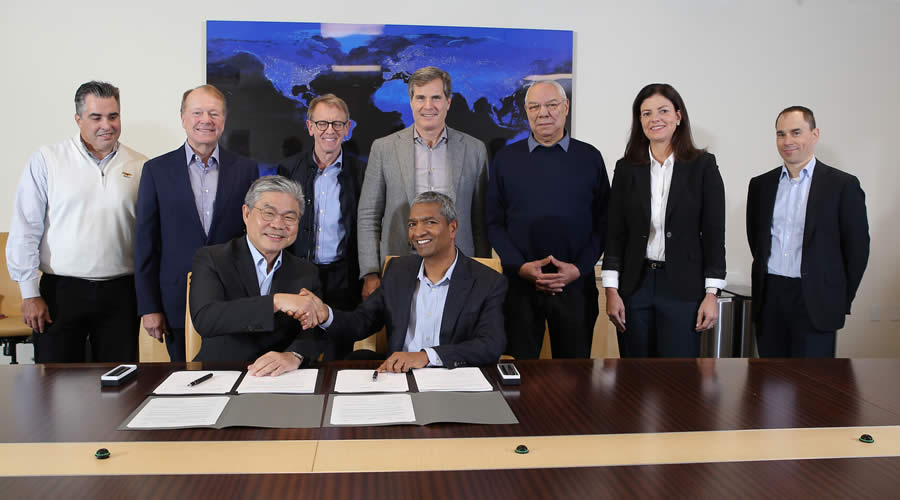 Korea is the most densely populated of the world’s major economies, with more than 50 million people inhabiting just 100,000 square kilometers. Limited space availability and poor air quality have spurred the adoption of advanced energy solutions, such as fuel cells, that offer both high power density and reduced air pollutants. In fact, South Korea has become a world leader in the deployment of fuel cells for utility-scale electric power generation with approximately 300 megawatts deployed at the start of the year.
Korea is the most densely populated of the world’s major economies, with more than 50 million people inhabiting just 100,000 square kilometers. Limited space availability and poor air quality have spurred the adoption of advanced energy solutions, such as fuel cells, that offer both high power density and reduced air pollutants. In fact, South Korea has become a world leader in the deployment of fuel cells for utility-scale electric power generation with approximately 300 megawatts deployed at the start of the year.
In January, we shared the exciting news that the country would be expanding its fuel cell deployments further with Bloom’s technology. We announced that SK E&C would supply Bloom Energy Servers to Korea Midland Power Co. (KOMIPO), one of Korea’s six regional power generation companies, and to KT Corporation (formerly known as Korea Telecom), South Korea’s largest telecommunications company. 7.8 megawatts in total, the projects will provide electricity directly to the national grid, powering more than a combined 15,600 homes.
Watch Bloom’s “Behind the News” for more on our projects in Korea
February: We powered on our first onsite biogas solution at a landfill
 Waste in landfills generated more than 100 million metric tons of carbon dioxide (CO2) equivalents last year. That’s about as much CO2 as burning 109 billion pounds of coal. What if, instead, we captured that methane and used it to generate clean, renewable electricity?
Waste in landfills generated more than 100 million metric tons of carbon dioxide (CO2) equivalents last year. That’s about as much CO2 as burning 109 billion pounds of coal. What if, instead, we captured that methane and used it to generate clean, renewable electricity?
With the help of our partners, that’s what we set out to do. We worked to develop a clean-up system that could couple with a standard Bloom Energy Server to effectively produce clean electricity using raw biogas from landfill – operating at full capacity. In February, we began generating electricity with Bloom’s first onsite biogas-powered solution in the Southeast in collaboration with our long-time partner, Southern Company. The 50 kilowatt Bloom Energy Server has since operated and generated 100 percent clean and renewable baseload power for the local grid.
For more on biogas, check out our blog: Coming Soon: 100% Renewable Electricity from Trash
March: We installed our 80th microgrid at Extreme Networks
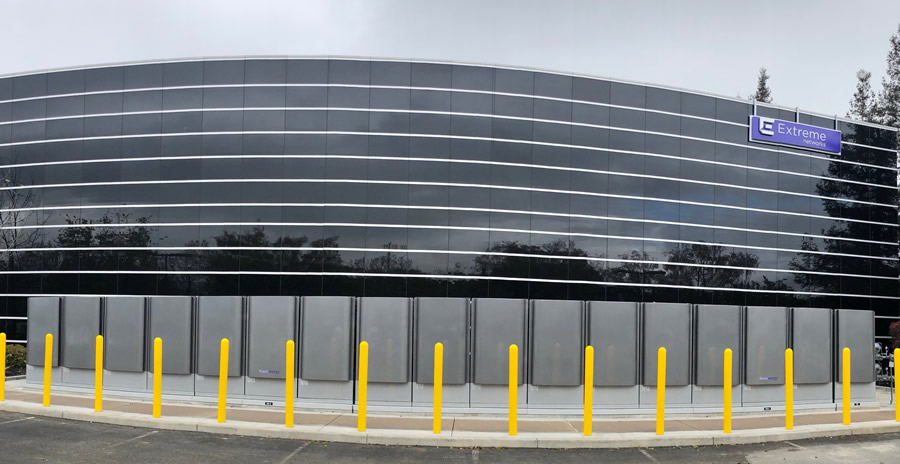 In the U.S. alone, the Eaton Blackout Tracker tallied 3,526 utility power outages in 2017, a 60 percent increase over the past 10 years. Grid reliability and power quality concerns have driven significant demand for Bloom-powered microgrids, and in March, we announced our 80th microgrid deployment at Extreme Networks’ headquarters in Silicon Valley.
In the U.S. alone, the Eaton Blackout Tracker tallied 3,526 utility power outages in 2017, a 60 percent increase over the past 10 years. Grid reliability and power quality concerns have driven significant demand for Bloom-powered microgrids, and in March, we announced our 80th microgrid deployment at Extreme Networks’ headquarters in Silicon Valley.
After experiencing three separate outages in its San Jose offices in the summer of 2018, Extreme’s leadership sought a sophisticated, alternative energy supplier. The Bloom-powered microgrid will provide an uninterrupted electricity supply to critical engineering and IT activities that support Extreme’s global business, even if the grid fails. As our economy continues to grapple with the causes and consequences of climate change, it’s likely there will be many more stories like Extreme’s.
Learn more about the surge in microgrid adoption in 2019
April: We deployed Energy Servers for an urban community in LA, The Alhambra
 The Ratkovich Company (TRC), a premier Los Angeles real estate development firm, was one of Bloom’s first customers in 2010. In April of this year, TRC adopted the latest generation of Bloom’s technology to provide clean, reliable power onsite at The Alhambra campus – a LEED Gold certified, mixed-use health-and-wellness-focused community, home to major tenants such as County of Los Angeles, USC Keck School of Medicine, and Eastern Los Angeles Regional Center (ELARC).
The Ratkovich Company (TRC), a premier Los Angeles real estate development firm, was one of Bloom’s first customers in 2010. In April of this year, TRC adopted the latest generation of Bloom’s technology to provide clean, reliable power onsite at The Alhambra campus – a LEED Gold certified, mixed-use health-and-wellness-focused community, home to major tenants such as County of Los Angeles, USC Keck School of Medicine, and Eastern Los Angeles Regional Center (ELARC).
“Back in 2010, we were among the first to deploy this extraordinary technology,” said Wayne Ratkovich, President/CEO of TRC. “Thanks to Bloom Energy Servers, our electric bills have been lowered significantly, as well as our carbon footprint. Now that we’re meeting approximately 75% of our total energy demand and have achieved an Energy Star score of 91, we hope to inspire other communities to reduce their reliance on the grid.”
For a behind the scenes look at The Alhambra project, watch Bloom’s “Behind the News”
May: We convened 300+ thought leaders for the ASPIRE Forum
 In May, more than 300 executive, political, industry, and regulatory leaders gathered in California for the ASPIRE Forum, an energy and sustainability thought leadership event convened by Bloom Energy and Morgan Stanley. We created the ASPIRE Forum to facilitate intelligent dialogues about the solutions, practices, and policies required to comprehensively address the causes and consequences of climate change.
In May, more than 300 executive, political, industry, and regulatory leaders gathered in California for the ASPIRE Forum, an energy and sustainability thought leadership event convened by Bloom Energy and Morgan Stanley. We created the ASPIRE Forum to facilitate intelligent dialogues about the solutions, practices, and policies required to comprehensively address the causes and consequences of climate change.
This year’s event, our fifth, featured keynote speakers including Laszlo Varro, Chief Economist of the International Energy Agency, Neil Chatterjee, Chairman of the Federal Energy Regulatory Commission, Charlie Baker, Governor of Massachusetts, Stacey Cunningham, President of the New York Stock Exchange, and California Lieutenant Governor Eleni Kounalakis.
June: We shared a new capability to operate Energy Servers on renewable hydrogen
 Today, excess renewable power is typically curtailed, impacting project economics and making new wind and solar deployments less attractive to investors. Instead of curtailing excess power, renewables can be used to produce hydrogen from water via electrolysis. Renewable hydrogen can be stored indefinitely where it is produced, or in large storage and pipeline networks like the natural gas system.
Today, excess renewable power is typically curtailed, impacting project economics and making new wind and solar deployments less attractive to investors. Instead of curtailing excess power, renewables can be used to produce hydrogen from water via electrolysis. Renewable hydrogen can be stored indefinitely where it is produced, or in large storage and pipeline networks like the natural gas system.
In June, we announced a new capability for Bloom Energy Servers to operate using pure hydrogen, or a blend of hydrogen and natural gas, as fuel. The announcement sets up a symbiotic relationship between wind and solar power, and fuel cells powered by hydrogen produced with excess renewables. Bloom Energy Servers can use the hydrogen to deliver baseload electric power 24 hours per day, 365 days per year, providing the perfect always-on companion to intermittent wind and solar power.
Learn more about the vital partnership between fuel cells and renewables in the race to decarbonize
July: A subsidiary of Duke Energy made a $250M investment in our technology
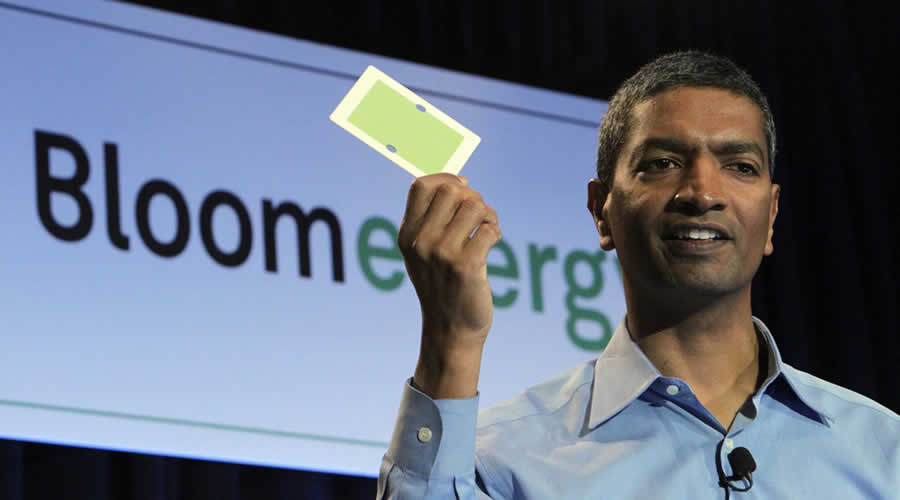 In July, we were pleased to announce that Duke Energy One would acquire approximately 37 megawatts of Bloom Energy Server projects through a power purchase agreement mechanism. Duke recognized that commercial and industrial customers increasingly need power that is reliable, resilient, and affordable, and its investment is a significant validation of the Bloom Energy Server value proposition.
In July, we were pleased to announce that Duke Energy One would acquire approximately 37 megawatts of Bloom Energy Server projects through a power purchase agreement mechanism. Duke recognized that commercial and industrial customers increasingly need power that is reliable, resilient, and affordable, and its investment is a significant validation of the Bloom Energy Server value proposition.
Duke Energy One has already secured long-term power purchase agreements with creditworthy customers primarily located in California, Connecticut, Maryland, and New York. We announced we would deploy Energy Servers at more than 30 sites across a portfolio of customers throughout the following 18 months, including hospitals, technology companies, data centers, and universities.
Read more about our strategic alliance with Duke Energy
August: We launched our AlwaysON Microgrid solution
 As extreme weather events integrate into the nation’s DNA, energy challenges and power supply disruptions are becoming more and more common. Hurricanes, heatwaves, wildfires, and storms are increasingly impacting businesses and communities across the U.S. In California, utilities began implementing Public Safety Power Shutoffs (PSPS) in an attempt to mitigate the risk of wildfires, instructing customers to prepare for proactive outages lasting several days at a time. On the East Coast, heat waves and storms caused blackouts for hundreds of thousands of customers in New York and New Jersey.
As extreme weather events integrate into the nation’s DNA, energy challenges and power supply disruptions are becoming more and more common. Hurricanes, heatwaves, wildfires, and storms are increasingly impacting businesses and communities across the U.S. In California, utilities began implementing Public Safety Power Shutoffs (PSPS) in an attempt to mitigate the risk of wildfires, instructing customers to prepare for proactive outages lasting several days at a time. On the East Coast, heat waves and storms caused blackouts for hundreds of thousands of customers in New York and New Jersey.
In response to this ‘new normal,’ we launched a new AlwaysON Microgrid solution with attractive financing, designed to make it easier and more convenient for companies to protect themselves from extended power outages and escalating grid electricity rates. Companies depend on our microgrid solution – which can operate independently of the main electrical grid indefinitely – to protect them from both planned and unplanned outages.
Discover how Bloom’s microgrids help businesses and communities power through outages
September: We announced a new collaboration with Samsung to build fuel cell-powered ships
 Today, 80 percent of the world’s shipping fleet runs on heavy fuel oil, or bunker fuel. The combustion of this fuel to provide propulsion and auxiliary power to ships causes the marine transport industry to produce between 2 percent and 3 percent of global carbon emissions. In fact, if the global marine shipping industry was a country, it would be the sixth largest producer of greenhouse gas (GHG) emissions in the world.
Today, 80 percent of the world’s shipping fleet runs on heavy fuel oil, or bunker fuel. The combustion of this fuel to provide propulsion and auxiliary power to ships causes the marine transport industry to produce between 2 percent and 3 percent of global carbon emissions. In fact, if the global marine shipping industry was a country, it would be the sixth largest producer of greenhouse gas (GHG) emissions in the world.
In September, we announced we would bring our fuel cells to sea to help combat this problem. We’re teaming up with Samsung Heavy Industries (SHI), a part of Samsung Group, to design and develop ships powered by our technology. We estimate that replacing oil-based power generation on large cargo ships, which require up to 100 MW of power per ship, could reduce annual greenhouse gas emissions from shipping by 45 percent. We believe this is a substantial market opportunity. The global shipping industry today has more than 126,000 ships using more than 600 gigawatts (GW) of power – and it is estimated that around 2,000 to 2,500 ships annually will be added to the global fleet over the next five years. Today, the typical Bloom installation size on land is below 5 megawatts – and each ship uses anywhere from 19 to 100 megawatts of power. As we’ll be supplying fuel cells to generate power for a portion of or the total power need, we see great potential.
Learn more about our plans to bring fuel cells to sea
October: We teamed up with CalBio to turn dairy waste into renewable energy
 Greenhouse gases pose great threats to climate change because they trap heat in the earth’s atmosphere, causing temperatures to rise on the ground. And in fact, methane is especially threatening as it has a 25 times greater impact on global warming than carbon dioxide emissions.
Greenhouse gases pose great threats to climate change because they trap heat in the earth’s atmosphere, causing temperatures to rise on the ground. And in fact, methane is especially threatening as it has a 25 times greater impact on global warming than carbon dioxide emissions.
In October, we announced an exciting new collaboration with California Bioenergy (CalBio) to help combat this problem – by turning dairy waste into clean energy in California. CalBio’s dairy digester technology combined with our solid oxide fuel cell technology will deliver an end-to-end solution for the capture of methane from cow manure to the generation of renewable electricity, which has been designed to power electric vehicles (EVs) throughout the state. The opportunity to power EVs with cow manure is, well, huge. If all of the economically viable dairy biogas in California was utilized to generate electricity, it would produce more than 300 megawatts of power. That’s enough to power approximately 600,000 EVs, each traveling 15,000 miles per year.
November: We added two new board members, Stanford’s Michael Boskin and Former GE CEO Jeff Immelt
In November, we were thrilled to announce that Dr. Michael J. Boskin, the Tully M. Friedman Professor of Economics and Wohlford Family Senior Fellow at Stanford University’s Hoover Institution, and Jeffrey Immelt, former Chairman and CEO of GE (NYSE: GE) and current Venture Partner of New Enterprise Associates, would join the company’s Board of Directors, expanding the Board from eight to 10 directors.
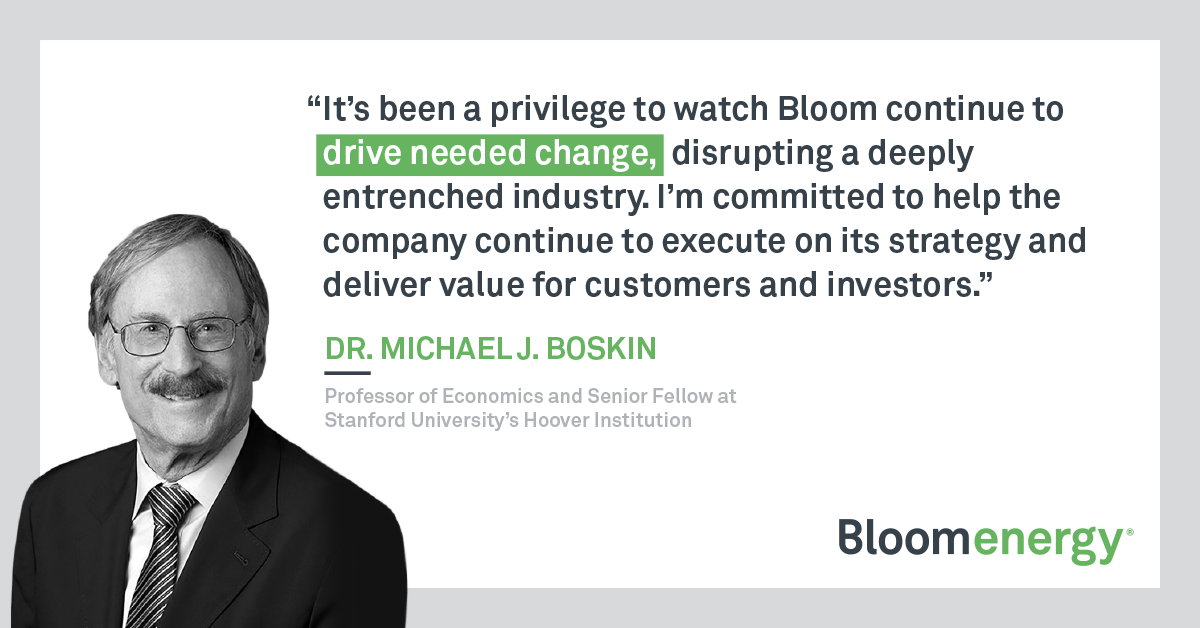
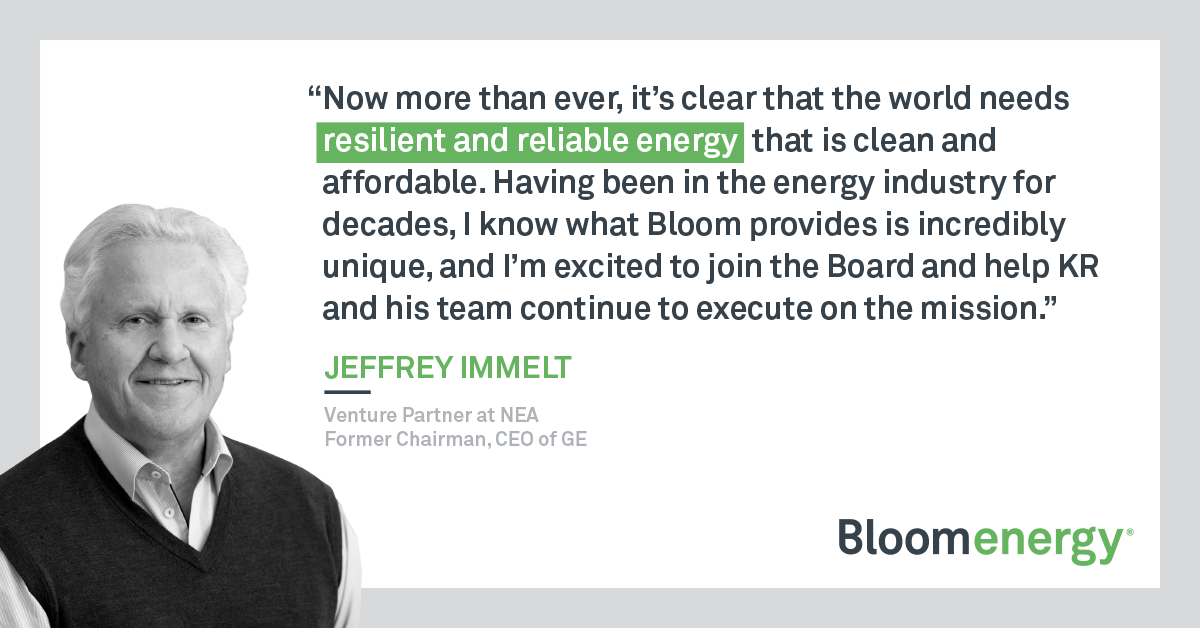
See Bloom’s full Board of Directors
December: We supported the communities we call home
This holiday season, we worked to support our communities from coast to coast. In Delaware, our team donated more than 1,600 pounds of food to the Food Bank, which provides nutritious foods to Delawareans in need and facilitates long-term solutions to the problems of hunger and poverty through community education and advocacy. The team also hosted students from Appo School District’s Engineering Pathway program for a STEM career panel and interactive LEAN manufacturing workshop.
Our California team joined the Family Giving Tree’s annual Holiday Wish Drive, an initiative dedicated to bringing joy during the holidays through giving. The team helped fulfill the wishes of more than 100 local children and families through donations. Thanks to our employees and our partner organizations for spreading the cheer this holiday season!


Connect with the Bloom team on LinkedIn
Thank you to our team, partners, and customers for making 2019 an outstanding year. With each development, we grow one step closer to fulfilling our mission.
We can’t wait to see what 2020 will bring!



